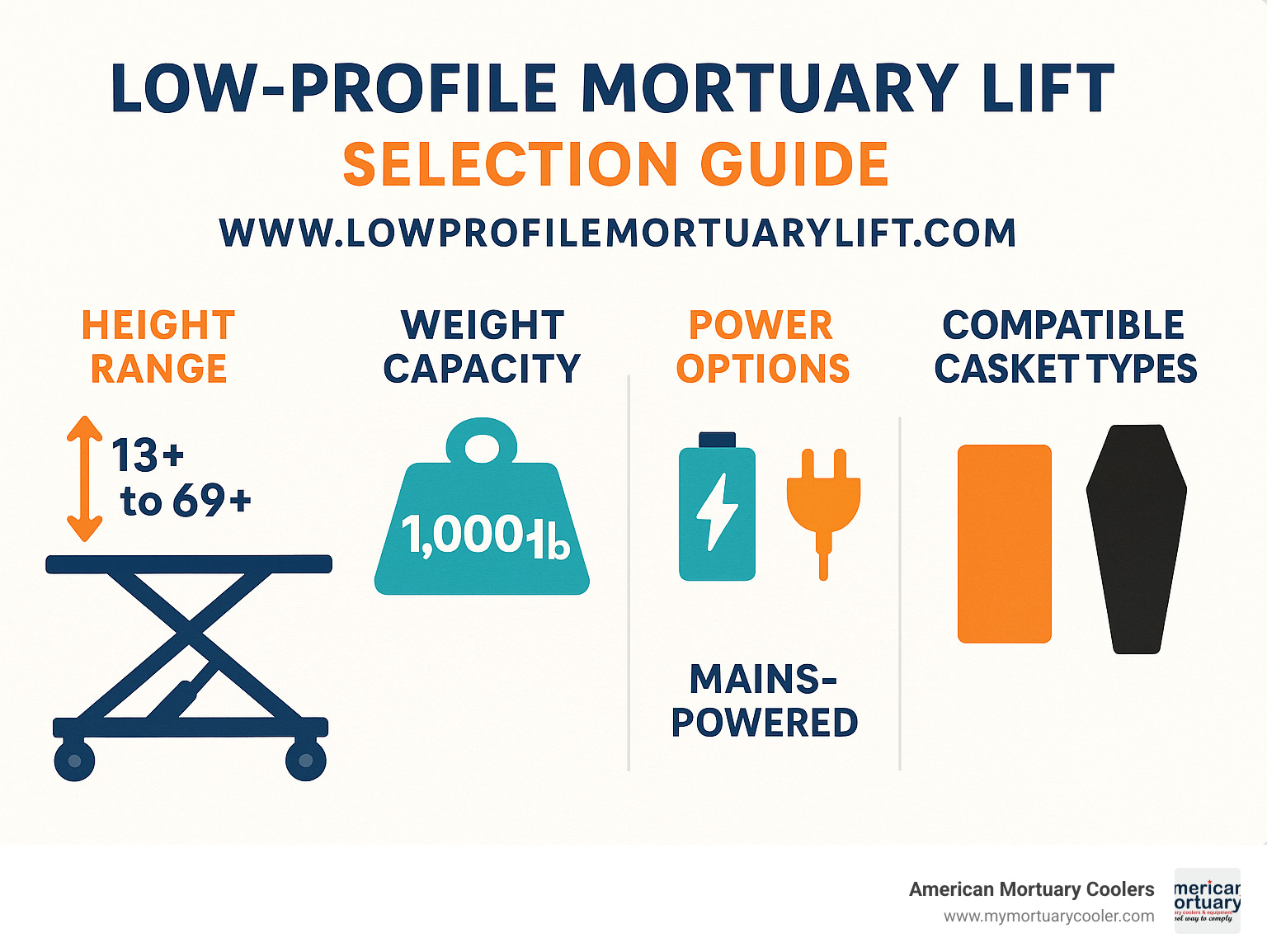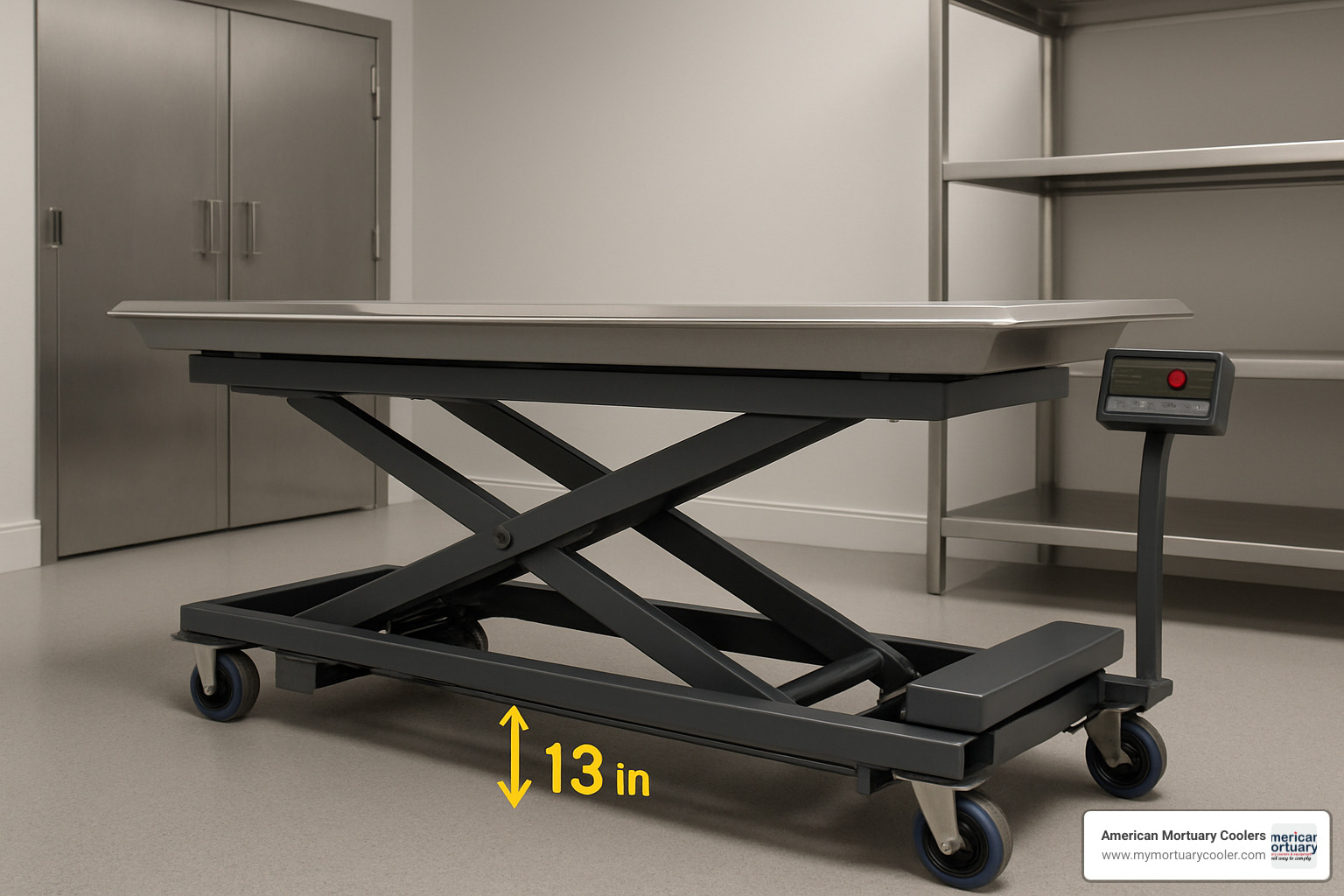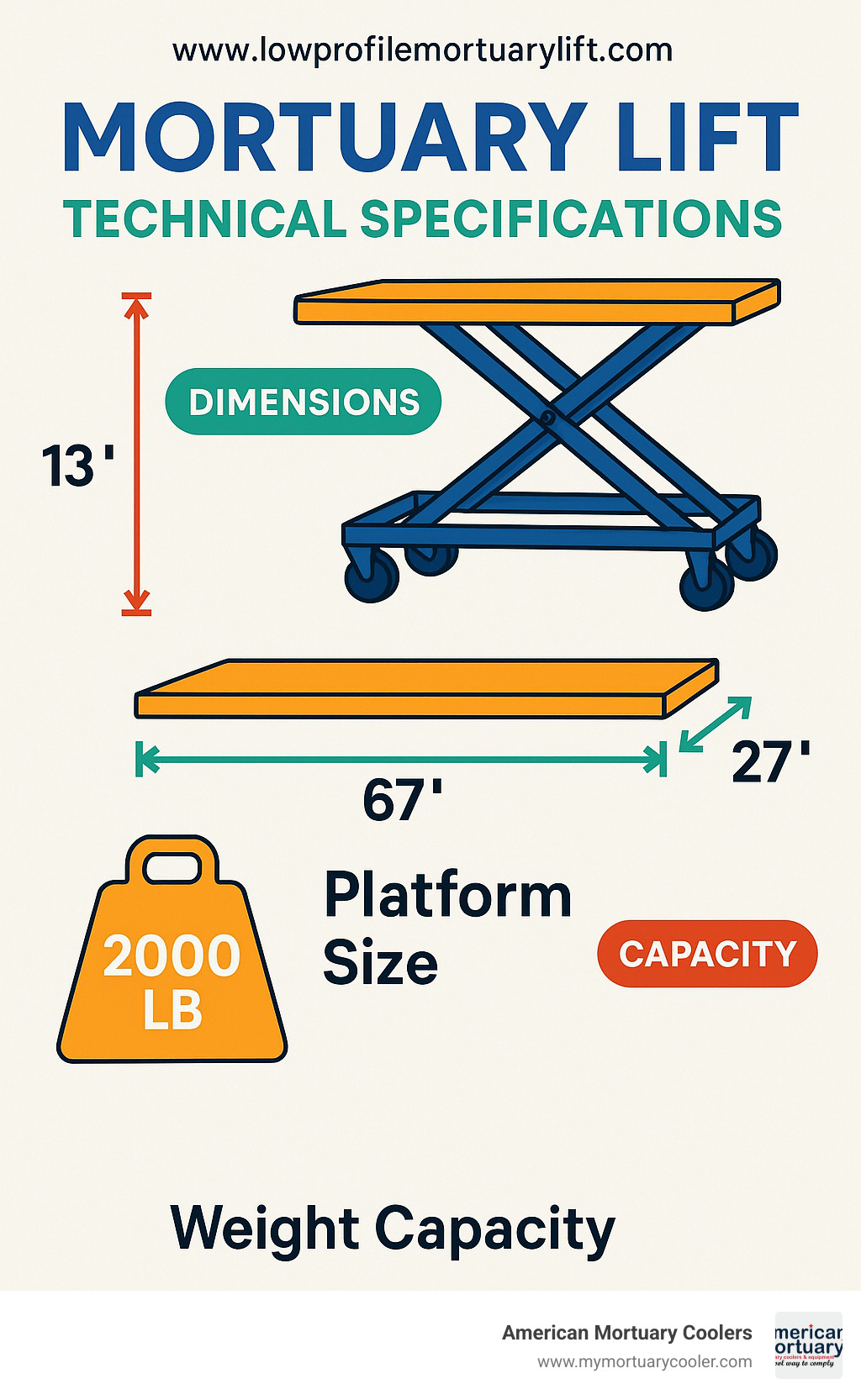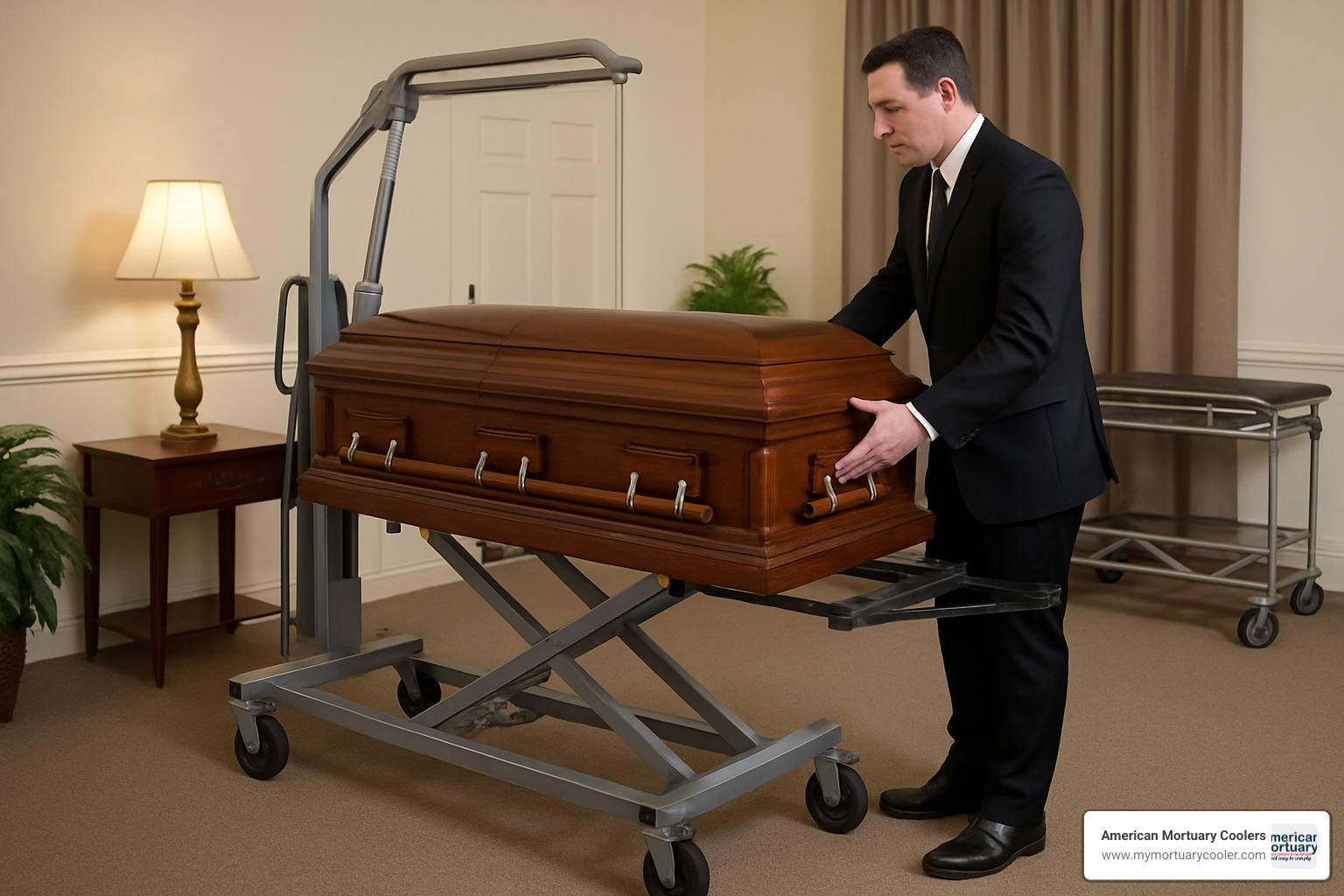The Essential Guide to Low-Profile Mortuary Lifts for Funeral Professionals
If you're searching for specialized mortuary lifting equipment, you're looking for solutions with these key features:
- Ultra-low 13" profile for easy loading and unloading
- 1,000+ lb weight capacity for handling heavy caskets and remains
- Multi-directional rollers for side-load and end-load flexibility
- Made in the USA (South Carolina manufacturing facility)
- Optional LCD digital scale for integrated weight measurement
- 69"+ maximum lift height accommodating various storage needs
- Dimensions of 67" x 27" for standard casket compatibility
In the demanding environment of funeral service, every movement matters. The right equipment doesn't just save time—it preserves dignity, protects staff from injury, and ensures smooth operations during the most sensitive moments of service. Low-profile mortuary lifts represent a critical investment for funeral homes, crematories, and medical examiner facilities seeking to optimize workflow while minimizing physical strain.
"The Battery Scissor Lift meets my needs perfectly and I am quite satisfied with its operation and overall quality," reports one funeral director who found the difference a purpose-built lift can make. This sentiment echoes throughout the industry as professionals move away from general-purpose equipment toward specialized solutions designed specifically for mortuary applications.
I'm with American Mortuary Coolers, a national-level mortuary equipment supplier with extensive experience helping funeral professionals find the right equipment to meet their specific handling needs and facility constraints.

What Is a Low-Profile Mortuary Lift?
Ever walked into a funeral home and wondered how they move those heavy caskets so smoothly? That's where specialized mortuary lifts come in. These aren't just another piece of equipment – they're dedicated lifting solutions created specifically for funeral professionals who need reliability when handling their most sensitive tasks.
The star of the show is the Electric Crematory Scissor Lift, a product born from years of listening to what funeral directors, crematory operators, and medical examiners actually need. What makes these lifts special? They start at just 13 inches off the ground – about the height of a pizza box – making them perfect for those tight spaces where every inch matters.
Behind these specialized lifts are manufacturers proudly building them right here in the USA. There's something reassuring about American-made equipment when you're trusting it with such important work, isn't there?

The Electric lift isn't just strong – it's smart too. With multi-directional rollers, you can load from the side or end, giving you flexibility when working in cramped spaces. And with a capacity exceeding 1,000 pounds, it handles everything from lightweight cremation containers to full caskets without breaking a sweat.
Product Lineup
When exploring mortuary lift options, you'll find several thoughtfully designed choices:
The Electric Crematory Scissor Lift is the bread and butter – battery-powered with whisper-quiet operation that won't disturb the solemn atmosphere of your facility. It glides smoothly from 13 inches all the way up to 69 inches high.
For the traditionalists (or as a never-fails backup), the Heavy-Duty Manual Hydraulic Crematory Scissor Lift offers reliability without dependency on electricity. There's something reassuring about equipment that works even during power outages.
Working in an extremely tight space? The Compact Low Profile Mortuary Lift maintains all the essential features while taking up less floor space.
For environments where sanitation is paramount, the Stainless Steel Crematory Battery Powered Lift stands up to harsh cleaning chemicals and frequent disinfection.
And if you're looking for something lighter to maneuver without sacrificing strength, the Marine-Grade Aluminum HD Mortuary Lift offers the perfect balance.
Each model can include an optional LCD digital scale built right into the platform – no more transferring remains to a separate scale and back again. It's these thoughtful touches that show manufacturers understand the daily challenges funeral professionals face.
Ordering Process
Getting your hands on one of these lifts is straightforward, though it does require a bit of planning. These aren't mass-produced items gathering dust in a warehouse – they're built specifically for you.
Start by requesting a quote, where you'll specify exactly what you need. Not sure which features match your workflow? Representatives who understand funeral operations can help guide your decision.
Since each lift is custom-built to your specifications, expect about 5-6 weeks from order to delivery. Yes, that means planning ahead, but wouldn't you rather have equipment that fits your needs perfectly instead of something generic that "mostly works"?
When your lift is ready, it ships directly to your facility anywhere in the continental United States. At American Mortuary Coolers, we've found our customers appreciate this direct shipping approach – no middlemen means both better prices and better accountability.
Worried about the upfront cost? Qualified buyers can take advantage of financing options. This makes it much easier to get the equipment you need now while spreading payments over time – particularly helpful for smaller funeral homes or those in the middle of facility upgrades.
Want your lift to match your facility's look? Custom colors are available and can even include your facility's logo, ensuring your equipment looks as professional as the services you provide. After all, attention to detail is what sets great funeral homes apart – down to their equipment.
Essential Features & Technical Specifications of Low Profile Mortuary Lifts
When you invest in a mortuary lift, you're getting equipment specifically engineered for the unique demands of funeral service. These aren't generic industrial lifts—they're purpose-built tools designed with your daily challenges in mind.
The standard height range tells the story: these lifts start at a mere 13 inches from the floor and extend to an impressive 69+ inches at full extension. Why does this matter? Because this range lets you easily slide the lift under a body tray resting on the floor, then raise it smoothly to the exact height of your preparation table, storage rack, or cremation retort—all without manual lifting.

The platform dimensions—67 inches by 27 inches—accommodate standard caskets and body trays perfectly. No awkward overhang, no balancing act, just stable, secure transport. The electric models run on a reliable 12V DC battery system that powers multiple lift cycles before needing a recharge, offering quiet operation that respects the solemn nature of your work.
Safety isn't an afterthought—it's built into every inch of these lifts. Roller locks secure the platform during loading and unloading, while toe guards protect staff from potential injuries during lowering. The emergency stop button provides immediate halting capability, and overload protection prevents operation beyond the rated capacity, giving you peace of mind with every use.
Durability comes from thoughtful material selection: powder-coated steel frames provide the backbone, with marine-grade aluminum options available when weight reduction matters. Every component is chosen to withstand the unique environmental challenges of funeral service.
For a deeper dive into best practices, check out our guide on Safe Handling Practices with Mortuary Lift Equipment, and review the OSHA material handling guidelines for additional safety insights.
Ultra-Low Height & Heavy Capacity
The 13-inch clearance height is truly where these lifts shine. This isn't just a specification—it's freedom from one of the most injury-prone moments in mortuary operations: that initial manual lift from floor level.
"My back thanks me every day," one funeral director told us after switching to a low-profile lift. "We used to dread floor pickups, but now it's just part of the routine."
With weight capacities exceeding 1,000 pounds, these lifts handle everything from standard cases to bariatric situations with confidence. The substantial rating accommodates oversized caskets, heavier remains, and the combined weight of additional equipment without strain or hesitation.
The multi-directional roller system might be my favorite feature to show customers during demonstrations. Unlike conventional lifts that force you into end-loading only, these systems allow both side-loading and end-loading. This flexibility is invaluable when you're working in tight preparation rooms or crematory areas where wall placement limits your maneuvering options.
Safety Systems & Compliance
In our industry, safety isn't just about preventing workplace injuries—it's about preserving dignity throughout every transfer. The specialized mortuary lifts approach safety from this dual perspective.
The roller brake system consistently earns praise from users. As one funeral director put it, "I like how the Roller Brake system works." These brakes secure the platform during those critical moments of transfer, preventing any unexpected movement that could compromise safety or dignity.
Lock-out switches provide peace of mind in facilities where public access might occur, preventing unauthorized operation when the lift isn't being actively used by staff. It's a small feature that makes a big difference in busy establishments.
While mortuary equipment doesn't fall under a single regulatory standard, these lifts are designed with OSHA workplace safety guidelines in mind. This attention to compliance helps your facility maintain proper standards without additional modification or adaptation.
Materials & Construction
The environment in a funeral home or crematory is uniquely challenging for equipment. Exposure to cleaning chemicals, biological fluids, and often high humidity levels demands materials that can withstand these conditions year after year.
Stainless steel welds form the critical junctures in these lifts, providing not just structural integrity but resistance to the corrosive effects of daily cleaning routines. For components where stainless isn't used, industrial-grade powder coating creates a protective barrier that prevents deterioration even in preparation room environments.
Every piece of hardware is selected with longevity in mind—stainless steel fasteners and components resist rusting and maintain their appearance through years of service. It's this attention to detail that extends the operational life of your equipment investment.
The "Made in USA" designation carries real weight here. These lifts are manufactured under strict quality control protocols, with each unit tested before shipping to ensure it arrives ready for immediate implementation. When a staff member's safety and a family's peace of mind are on the line, that quality assurance matters tremendously.
Buying Considerations, Power Options & Pricing
When shopping for a mortuary lift, there's quite a bit to think about beyond just the price tag. At American Mortuary Coolers, we've guided countless funeral directors through this decision, helping them find equipment that feels like it was made specifically for their facility.
First, take a good look at the caskets and trays you use most often. While the standard 67" × 27" platform works beautifully for most situations, if you regularly handle oversized caskets, you might need to consider custom dimensions. And don't forget about those tight hallway turns! Nothing's more frustrating than investing in equipment that won't steer your building's unique layout.
Your storage racks matter too. The standard maximum height of 69+ inches is designed to line up perfectly with common rack heights, but it's always worth taking measurements of your specific setup. Trust me, you'll appreciate that perfect alignment when you're transferring remains at the end of a long day.

When it comes to power options, you've got three main choices, each with its own set of pros and cons:
Manual hydraulic systems are the most straightforward – they require good old-fashioned elbow grease to pump the platform up, but they'll never leave you stranded with a dead battery. They're typically more budget-friendly upfront, though they do demand more physical effort from your staff.
Battery-powered systems offer that convenient push-button operation that many funeral directors love. With about 20-30 complete lift cycles per charge, they provide cordless flexibility throughout your facility. Just remember to plug them in overnight!
Electric systems with direct power connections eliminate battery concerns altogether, providing consistent performance for busy facilities. The trade-off? You're limited to areas with available power outlets.
Price-wise, quality mortuary lifts typically range from $5,500 to $8,000 depending on what features you need. Yes, that's a significant investment, but when you consider the reduced workplace injuries, improved efficiency, and equipment longevity, most funeral homes find the math works out in their favor pretty quickly.
Financing options can make this investment much more manageable, especially for smaller funeral homes or those in the middle of larger facility upgrades.
Don't overlook parts availability when making your decision. American-made lifts come with the peace of mind that replacement parts will remain available for years to come – something that can't always be said for imported alternatives that might become obsolete faster than you can say "discontinued model."
Matching Lift to Facility Workflow
The perfect mortuary lift isn't necessarily the one with all the bells and whistles – it's the one that feels like it was designed specifically for your funeral home's unique workflow. Before making your final selection, we recommend walking through your facility with a critical eye.
Start by measuring every doorway the lift will need to pass through. This is especially important in older buildings where doorways might be narrower than modern standards. The standard width of most mortuary lifts (27 inches for the platform plus frame dimensions) can sometimes present challenges, though some models offer collapsible side rails or removable components to help steer tight spaces.
Vehicle loading heights are another crucial measurement. If your team regularly transfers remains directly from preparation areas to vehicles, your lift's height range should align with your vehicle fleet's loading heights. This small detail can eliminate those awkward intermediate transfers that add time and compromise dignity.
Consider your staff's needs too. In facilities with aging team members or where back injuries have been an issue, electric or battery-powered options significantly reduce physical demands. On the flip side, facilities with limited technical support might prefer the mechanical simplicity of manual systems that are less likely to experience electronic hiccups.
By matching your lift to your specific workflow requirements, you'll maximize both efficiency improvements and injury reduction – the two biggest benefits these specialized tools provide.
Power Choices & Maintenance
The power system you select will significantly impact both your daily operations and long-term maintenance needs. Let's break down what you can expect from each option:
Manual Hydraulic Pumps are the workhorses of the industry. They require no electrical power or battery charging, typically cost less upfront, and provide reliable operation even during power outages. The trade-off is the physical effort required from operators. Maintenance-wise, you'll need to replace hydraulic fluid every 2-3 years, but troubleshooting and repairs are generally straightforward.
Sealed AGM Batteries deliver push-button convenience without cords, typically providing 20-30 complete lift cycles per charge. They require overnight charging for best performance and need replacement every 3-5 years depending on use. The good news is they include battery level indicators to prevent those awkward moments when you're mid-transfer and lose power.
110V Electric Systems eliminate battery charging concerns completely and provide consistent power for busy operations. The limitations? You're tethered to areas with available power outlets, and they typically come with the highest initial cost. Many include backup manual operation systems for power outages – a thoughtful feature when you need it most.
| Power Type | Advantages | Limitations | Maintenance Needs |
|---|---|---|---|
| Manual Hydraulic | No power dependency, Lower cost, Simplicity | Physical effort required, Slower operation | Fluid check annually, Seal replacement 5-7 years |
| Battery Powered | Cordless mobility, Push-button ease, Medium cost | Requires regular charging, Battery replacement costs | Battery charging after use, Battery replacement 3-5 years |
| Electric (110V) | Consistent power, No charging needed, Fastest operation | Limited to powered areas, Highest cost | Annual electrical inspection, Motor service every 5 years |
Regardless of which power type you choose, all mortuary lifts benefit from some TLC. Quarterly greasing of moving parts, annual inspection of lifting mechanisms, and regular cleaning of platforms and rollers will extend service life and ensure reliable operation when you need it most.
For hydraulic systems, we recommend annual cylinder checks to catch potential seal failures before they cause problems. If you go with a battery system, try to do monthly deep-cycle charging even during slower periods – your batteries will thank you with longer life and better performance when things get busy again.
Frequently Asked Questions about Low Profile Mortuary Lifts
How does a low profile mortuary lift differ from standard scissor lifts?
When funeral directors ask me this question, I always explain that the difference is like comparing dress shoes to work boots – both are footwear, but they're designed for completely different purposes.
Specialized mortuary lifts sit just 13 inches from the floor at their lowest position – a critical difference from standard industrial scissor lifts that typically start at 18-24 inches high. This ultra-low profile means you can slide the lift directly under a body tray resting on the floor without that initial manual lifting that puts so much strain on your back.
The platform dimensions tell another part of the story. While industrial lifts typically feature square platforms designed for pallets and boxes, mortuary lifts use rectangular platforms (typically 67" x 27") specifically designed to cradle caskets and body trays properly.
I've had funeral directors tell me they tried using industrial lifts before finding purpose-built mortuary lifts, and the difference was night and day. The multi-directional roller systems with proper locking mechanisms provide controlled movement specifically designed for the dignified handling of remains – something standard industrial lifts simply weren't designed to do.
There's also the matter of presentation. Mortuary lifts feature more refined finishes and significantly quieter operation – essential qualities when you're working in the presence of grieving families. The stark utilitarian design of industrial alternatives can feel out of place in the dignified setting of funeral service.
Remember too that while industrial lifts focus primarily on OSHA material handling compliance, mortuary lifts address the unique regulatory requirements and dignity considerations that come with handling human remains.
What weight capacities and platform dimensions are available?
"Will this lift handle everything we need it to?" This is one of the most common questions I hear from funeral professionals considering mortuary lift equipment.
The standard Electric Crematory Scissor Lift offers a robust weight capacity exceeding 1,000 pounds – more than enough for virtually any combination of remains and containers you'll encounter. I've worked with funeral homes serving communities with higher obesity rates, and even they find this capacity meets their needs consistently.
The standard platform dimensions of 67 inches by 27 inches accommodate everything from standard adult caskets (with room for up to 84" with some overhang) to oversized caskets when properly centered. The platform easily supports standard cremation containers and body trays up to 24" wide. Some of our smaller funeral home clients even appreciate being able to transfer multiple infant or child caskets simultaneously when necessary.
If your facility has unique needs, custom platform dimensions may be available upon request, though this might affect your lead time and pricing. I've worked with cremation-focused facilities that opted for slightly narrower platforms to improve maneuverability in their limited spaces.
The height range is equally impressive, starting at that crucial 13-inch minimum and extending to 69+ inches at maximum elevation. This range means you can start with floor-level loading (no manual lifting required), align perfectly with standard preparation tables (typically 32-36"), transfer to multi-level storage racks, and easily load into taller vehicles like hearses and removal vans.
What warranty, service, and parts support are offered?
Peace of mind matters tremendously when investing in essential equipment. Quality mortuary lifts come with comprehensive warranty coverage that reflects real confidence in their durability and performance.
While you should always confirm specific terms at purchase time, standard coverage typically includes a 1-year warranty on all mechanical components, 2-year coverage on hydraulic systems (where applicable), 1-year protection for electrical systems and batteries, and a limited lifetime warranty on structural frame components. That's protection you can count on.
"What happens if something goes wrong?" is always a valid concern. Service support is available through both direct manufacturer channels and authorized service partners throughout the United States. The domestic manufacturing location is a huge advantage here – it means faster response times and better parts availability compared to imported alternatives.
I've been impressed with how manufacturers maintain replacement parts for all current models and many legacy systems, with most components shipping within 24-48 hours after you place an order. They specifically keep critical components like hydraulic cylinders, control boards, and battery systems in inventory to prevent your equipment from sitting idle when you need it most.
For funeral homes with technically-inclined staff, comprehensive service manuals and troubleshooting guides come with the equipment, along with phone support for addressing common maintenance needs. When more complex issues arise, field service technicians can be dispatched to perform on-site repairs.
This level of support ensures your investment continues delivering value throughout its service life, with minimal interruptions for maintenance or repairs. In the funeral business, where equipment reliability directly impacts your ability to serve families with dignity, this peace of mind is invaluable.
Conclusion
When it comes to streamlining your mortuary operations, choosing the right low-profile lift isn't just about buying equipment—it's about investing in your staff's wellbeing and your facility's reputation. The specialized solutions for mortuary lifting address the unique challenges funeral professionals face daily, changing what was once a physically demanding and potentially hazardous task into a smooth, dignified process.
Think about it: with one integrated system handling transfers from initial pickup through final disposition, you eliminate those risky manual lifts that have caused so many back injuries in our industry. I've spoken with numerous funeral directors who tell me the same thing—once they implemented a proper mortuary lift, staff morale improved almost overnight.
"I used to dread when we'd get calls for larger individuals," one funeral director in Tennessee shared with me. "Now with our low-profile lift, that anxiety is gone. We know we can provide dignified care without risking our team's health."
The financial benefits extend well beyond the immediate operational improvements. When you reduce workplace injuries, you're also looking at lower insurance premiums over time. In an industry where finding and keeping good staff has become increasingly challenging, equipment that extends careers by preventing chronic injuries becomes priceless.
At American Mortuary Coolers, we understand that lifting equipment is just one piece of your comprehensive operation. Many of our clients find that upgrading their lifting systems naturally leads them to evaluate their refrigeration needs as well. If you're considering how these systems work together, I'd encourage you to explore our More info about mortuary coolers to find cooling solutions that complement your new lifting equipment.
We're proud to serve funeral professionals across the country with locations in Johnson City TN, Atlanta GA, Chicago IL, Columbia SC, Dallas TX, Los Angeles, New York NY, and Pittsburgh PA. Our regional coverage spans the Midwest, Northeast, Rocky Mountain, Southeast, Southwest, and Pacific regions, ensuring you receive personalized support regardless of where you're located.
The equipment you choose doesn't just make your job easier—it directly impacts the experience of grieving families during their most vulnerable moments. When you invest in specialized tools like low-profile mortuary lifts, you're making a statement about your commitment to excellence in every aspect of funeral service.
I've seen how the right equipment transforms not just operations, but the entire atmosphere of a funeral home. There's a quiet confidence that comes from knowing you have the tools to handle any situation with grace and dignity—and that's something families notice, even if they never see the equipment itself.
















